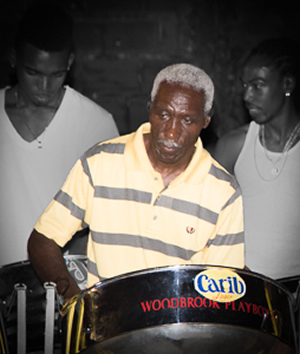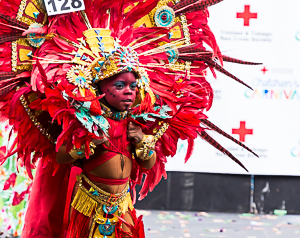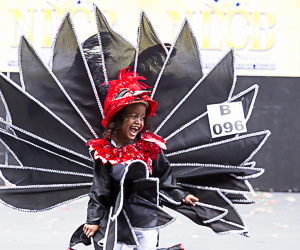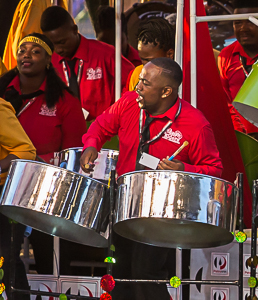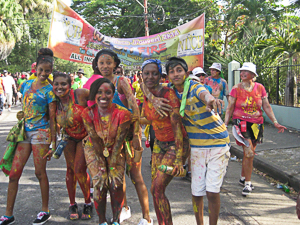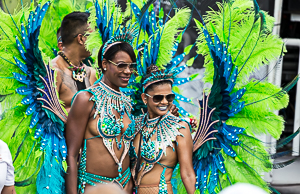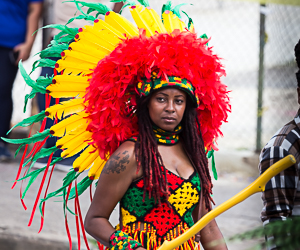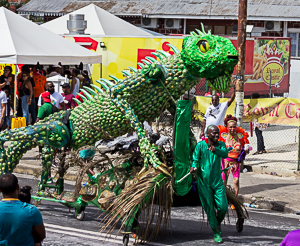Carnival in Trinidad and Tobago
The Calendar of Events:
There are a vast number of events over the carnival season. A listing of those that may be of interest to Cruisers can be found at - Events Schedule To make reservations for any event, contact Jesse James - Members only Maxi- Taxi and Tour Services at (868) 634-1658 or CH 68.
Please click on an image to see a larger version or to see related pictures.
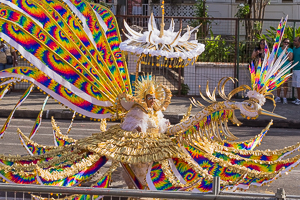
Some of the Carnival events include:
Pan Yards:
Pan music is a uniquely Trinidad invention. Each pan yard competes with each other for honers and prizes. The competition is high with honors and prizes going to the winner in many categories.
The Classic Carnival:
Many say that the big parades downtown have lost the "real" carnival spirit. The Old Time Carnival on the campus of the University of the West Indies has brought the classic carnival and its typical characters back for everyone to see. They tell the story of how carnival has evolved to its current form and in great detail about each of the major characters.
The Fancy Indian mas is a pretty mas characterized by elaborate headdresses (which can be taller that the mas performer), vibrant coloration, use of advanced wire bending work to support the costume, feather and beed work, inspired by native groups of south, central, and north american indigenous people, (“indians”). This mas grew out of, and is an extravagant offshoot of the Wild Indian Mas. There are several types of Wild Indian, with unique language practices (generally combinations and perversions of english, african, south american tribal, french, and spanish phrases) costume colors, and geographic origins. Fancy Indian bands are said to be influenced by the “Red Indians” the most, and have been reported to have entire dialogues memorized in an untranslatable, “nonsense” language, or to speak “Red Indian”. Many of today’s non-traditional costumes are heavily influenced by the Fancy Indian Tradition, including elaborate head dresses, use of bright feathers and bead work, and a costume profile emulating native groups. Reference Traditional Mas Archive
The sailor is perhaps the most popular traditional mas to play, due to its many variations, light weight, and inexpensive materials (please note the exception of the fancy sailor). The Caribbean has a long history of occupation by naval militaries, including the French, English, and American Navies. Over time, heightened, distorted, and/or satirical portrayals of various sailors became a staple of Carnival, especially for the versatility of the mas that allows for fancy portrayals (The Fancy/King variation), or non-fancy variations that embrace the bacchanal nature of “Bad Sailors” and “Sailors Ashore”. Reference Traditional Mas Archive
The Midnight RobberThe Midnight Robber is one of the most widely recognized and well-liked traditional carnival characters. Marked not only by his costuming, that includes a wide-brimmed hat and cape, the robber is also noted for use of “Robber Talk”: a boastful, articulate, and rhyming catalog of the robber’s deeds, conquests, history, and various abilities that often approach the supernatural. A conflation of many cultural influences, the most easily recognized influence on the robber is the costume profile and mannerisms of old west novels and cinema. A robber often relates his great ancestry as well, which, accompanied by rhythmic use of language and a detailed chronology has lead many say that ”Robber Talk” is derived from the tradition of the West African Griot (storyteller). Themes of speeches and confrontations between robbers often include quotations, rhetorical pyrotechnics, riddles, and allusions to popular history, religion, and mythology. Robber Masqueraders often have a variety of skulls on their person, and have been known to carry weapons (knives, swords, and guns) and coffins. In all cases, Robbers use a shrill “scout” whistle to punctuate their speeches and command the attention of an audience. Reference Traditional Mas Archive

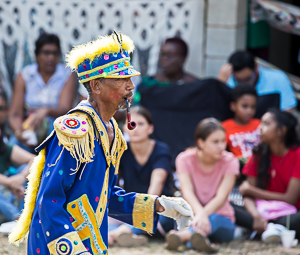
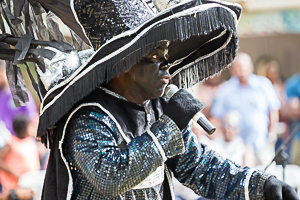
Children's Carnival
The Children's Carnival Parade is often on Carnival Saturday morning, but this year (2020) is was held on the stage at Queen's Park Savana. Children from babes in arms to teenagers participated. The level of skill and detail in the costumes was amazing.
Panorama
The first official Trinidad Panorama was held during Carnival celebrations in 1963. It was originally pioneered by Chairman of the Carnival Development Committee, Ronald Jay Williams, who gave the festival its name. Similarly styled "Panorama" steelband competitions are also staged at Carnival time in other Caribbean communities.
Typically, each steelpan orchestra plays a popular Calypso that is arranged into a piece with original introductions and variations.
As part of the International Conference on Pan (ICP) in August 2015, Trinidad hosted the International Panorama Competition. The international edition of Panorama was held over a two-day period, 8–9 August 2015. The competition brought together participants from the approximately 38 steelband-playing countries from around the world to compete against each other for the title of ICP Champions 2015.
In 1979, Panorama in Trinidad was not held due to Rudolph Charles' fight for higher recognition of pannists. The competition was again cancelled in 2021 and 2022 due to the COVID-19 pandemic.
It is held in Queen's Park Savannah, Port of Spain.
wikipedia
Jouvay
J'ouvert (translated from French as "break of day"), symbolizes the start of the official two days of Carnival. Beginning early Monday, revellers parade through town in the tradition of the Canboulay celebrations. Jouvay, as it is commonly known, features a variety of homemade or satirical costumes. This celebration involves participants dousing themselves in oil, mud and powder while they dance to calypso music through the streets. This is a stark contrast to the attractive and more formal costumes that are donned later in the day on Carnival Monday and on Tuesday.
The Main Carnival Parade - Pretty Mas
The Trinidad and Tobago Carnival is an annual event held on the Monday and Tuesday before Ash Wednesday in Trinidad and Tobago. It's origins go back to the 18th century with French plantation owners organizing masquerades (mas) and balls before enduring the fasting of Lent. The street parades are the culmination of weeks of competition and months or more of preparation. The groups or "bands" may consist of a few performers to huge bands of hundreds of people in costume supported by tractor trailer trucks with sound systems that would support a major rock concert, beverage trucks to keep the band in good spirits and trucks to allow them to take their leave.
Masquerade bands consisting of thousands of people 'jumping up' (dancing) in glittery, colourful and often revealing costumes rule the streets on Carnival Monday and Tuesday. Each band has its own historical, mythological or tropical concept with various sections depicting aspects of the main theme. The costumes are designed by the bands and vary from unblevably complex "front line" costumes to more modest, but just as revailing ones for the remainder of the group.
The Carnival Parade in Port of Spain is the largest in Trinidad and Tobago. Most smaller communities have their own. It begins at the Queen's Park Savana and winds its way through the streets of downtown Port of Spain. It is the only parade where the number of participants out number the spectators.
